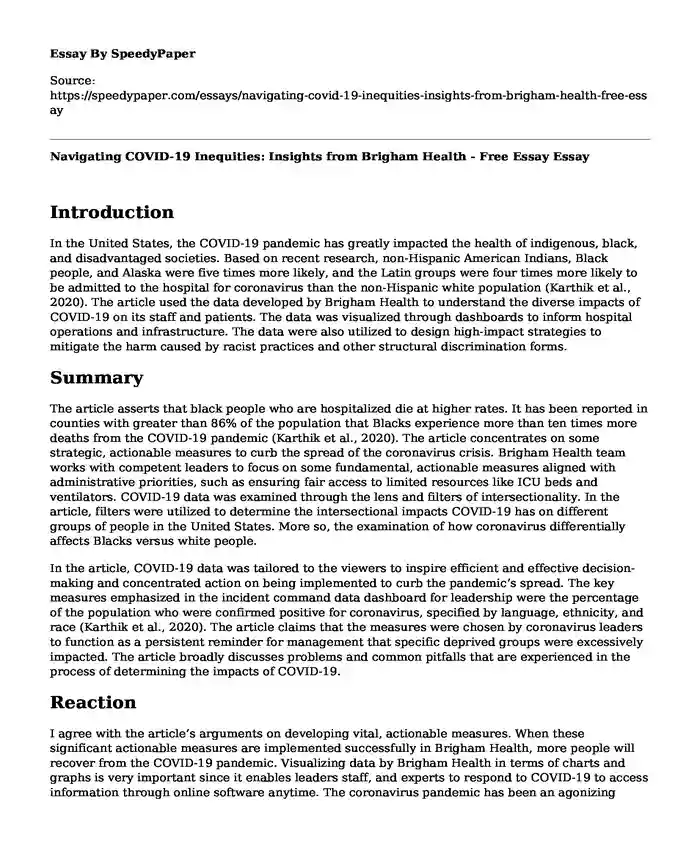
| Essay type: | Evaluation essays |
| Categories: | Health and Social Care United States Covid 19 |
| Pages: | 3 |
| Wordcount: | 591 words |
Introduction
In the United States, the COVID-19 pandemic has greatly impacted the health of indigenous, black, and disadvantaged societies. Based on recent research, non-Hispanic American Indians, Black people, and Alaska were five times more likely, and the Latin groups were four times more likely to be admitted to the hospital for coronavirus than the non-Hispanic white population (Karthik et al., 2020). The article used the data developed by Brigham Health to understand the diverse impacts of COVID-19 on its staff and patients. The data was visualized through dashboards to inform hospital operations and infrastructure. The data were also utilized to design high-impact strategies to mitigate the harm caused by racist practices and other structural discrimination forms.
Summary
The article asserts that black people who are hospitalized die at higher rates. It has been reported in counties with greater than 86% of the population that Blacks experience more than ten times more deaths from the COVID-19 pandemic (Karthik et al., 2020). The article concentrates on some strategic, actionable measures to curb the spread of the coronavirus crisis. Brigham Health team works with competent leaders to focus on some fundamental, actionable measures aligned with administrative priorities, such as ensuring fair access to limited resources like ICU beds and ventilators. COVID-19 data was examined through the lens and filters of intersectionality. In the article, filters were utilized to determine the intersectional impacts COVID-19 has on different groups of people in the United States. More so, the examination of how coronavirus differentially affects Blacks versus white people.
In the article, COVID-19 data was tailored to the viewers to inspire efficient and effective decision-making and concentrated action on being implemented to curb the pandemic’s spread. The key measures emphasized in the incident command data dashboard for leadership were the percentage of the population who were confirmed positive for coronavirus, specified by language, ethnicity, and race (Karthik et al., 2020). The article claims that the measures were chosen by coronavirus leaders to function as a persistent reminder for management that specific deprived groups were excessively impacted. The article broadly discusses problems and common pitfalls that are experienced in the process of determining the impacts of COVID-19.
Reaction
I agree with the article’s arguments on developing vital, actionable measures. When these significant actionable measures are implemented successfully in Brigham Health, more people will recover from the COVID-19 pandemic. Visualizing data by Brigham Health in terms of charts and graphs is very important since it enables leaders staff, and experts to respond to COVID-19 to access information through online software anytime. The coronavirus pandemic has been an agonizing reminder of the urgent requirement to handle inequities in the healthcare sector and the worrying lack of progress that different nations worldwide adopt to curb future emerging crises in the health sector.
I agree with the decision to use the lens of intersectionality to examine data about COVID-19. The use of filters enables people to further understand the diverse impacts of COVID-19 on both white and black women compared to men. The approach is very important since it reveals the inequities that would have otherwise remained unseen. The data examined through filters are crucial since it enables coronavirus equity committee associates to determine and escalate developing dangers to occasion command managers like determining higher death between Hispanic people who don’t speak English compared to Hispanic patients who speak English (Karthik et al., 2020).
Reference
Karthik S., Tam D., Shauna F., Cheryl C., & Sunil E. (2020). A Data-Driven Approaches to Addressing Racial Disparities in Health Care Outcomes. https://hbr.org/2020/07/a-data-driven-approach-to-addressing-racial-disparities-in-health-care-outcomes
Cite this page
Navigating COVID-19 Inequities: Insights from Brigham Health - Free Essay. (2024, Jan 04). Retrieved from https://speedypaper.net/essays/navigating-covid-19-inequities-insights-from-brigham-health-free-essay
Request Removal
If you are the original author of this essay and no longer wish to have it published on the SpeedyPaper website, please click below to request its removal:
- Critical Response to "Eat that Frog!" book by Brian Tracy
- Understanding Correlation of Depression & Anxiety. Paper Example
- Essay Sample on Sustaining Physical Exercise Against Obesity: Achieving Long-Term Health Benefits
- Free Essay Example - Asian Culture on an Oral Health Basis
- Essay Example on Health Disparities in America
- Essay Example on My Reasons for Pursuing Clinical Psychology
- Nurturing Hope: Literary Inspirations Amidst the Pandemic - A Free Essay
Popular categories




